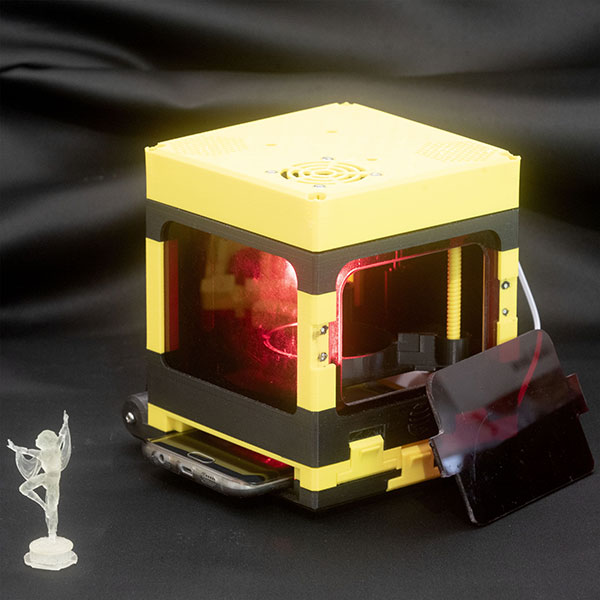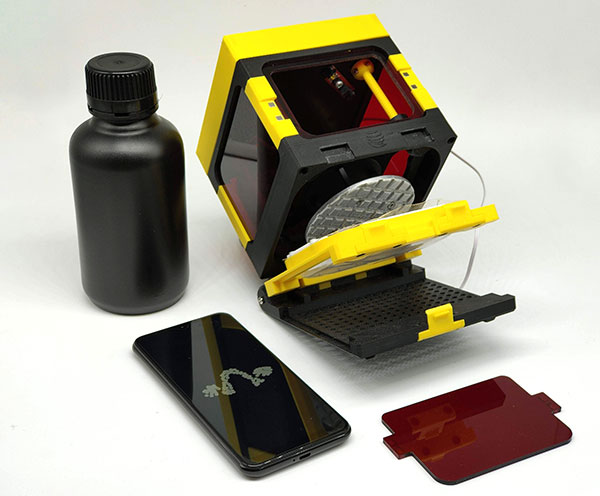3D Resin Printer That Users Can Create
The LumiBee is a compact 3D printer that uses photosensitive liquid resin.

Image courtesy of LumiBee.
Latest News
December 27, 2019
LumiBee from Lumi Industries is a mini 3D resin printer that uses a smartphone as a light source to polymerize the resin. The project is free for everyone who wants to create their own device at home. To create it, you will need a LPD (line print daemon) printer. The LumiBee prototype was created on the Zortrax M200 3D printer.
The LumiBee is a compact 3D printer that uses photosensitive liquid resin. It has been designed so that most of its parts can be printed with a desktop LPD 3D printer. The LumiBee uses the screen of a mobile phone, inserted inside, to transform daylight liquid resin into a three-dimensional object. Daylight resin for 3D printing allows most smartphones to be used as a light source to solidify the resin.
“I made LumiBee as a personal project. I developed [the] mechanical design, PCB design, prototyping, firmware and App. I made first prototypes for the chassis using the FFF 3D printer we have in-house, a Zortrax M200 and Z-ULTRAT filament. M200 provided us with everything we needed,” says Davide Marin, Lumi Industries CEO.
“The quality was good enough even to print threaded bars and nuts for LumiBee Z-axis,” Marin adds. “An idea popped into my mind: LumiBee parts should be designed in a way that any user can 3D print them at home with a domestic FFF printer at a very low cost. I decided with my team to release LumiBee as a free Open Source project by Lumi Industries, perfectly matching our mission to make 3D printing benefits available to a larger public.”
The LumiBee chassis design was split into “segments” with specific functions: holding the phone, housing the PCB board, etc., and they can be customized or replaced easily.
In the prototyping process, each segment was printed in a different color to highlight this feature. The name LumiBee stems from the two filament colors available at the prototyping stage: black and yellow. The finished device resembled a bee.

“In nature, this tiny animal has such an important role in our lives. It contributes to complex, interconnected ecosystems and we felt this reflected also the idea of the project itself involving different players like makers, 3D printing lovers and fans, as well as different companies to cooperate for the good and, if possible even improved, outcome of the project,” adds Marin.
Partners of the project are Photocentric, providing suitable daylight resins; Zortrax—creator of the printer on which LumiBee was printed; and 3D Filium, suggesting particular filaments, like their new coming non-flammable PlaQ FRVO, for extra safety when embedding electronic components.
“We are glad that users of Zortrax printers use our equipment for creative projects and share their solutions with the tech enthusiasts community,” says Rafał Tomasiak, CEO of Zortrax. “The ability to create your own devices, modify and improve them is one of the most important things 3D printing brings to the table. We are excited to see how people will transform and modify LumiBee in the future.”
LumiBee communicates easily with any smartphone in the market, the company says. Every smartphone has a built-in flash for the rear camera, and accessing it is easy in Android studio. Communication protocol was reduced to the bare minimum, using a quick blink of the smartphone flash to say “go up 1 layer in the Z-axis” to LumiBee and two quick blinks to communicate “print is finished, put the tray completely out of the resin.”
LumiBee was a finalist in 2019 edition of the Purmundus challenge at FormNext, Frankfurt, Germany. The M200 3D printer model used to create the LumiBee is the predecessor of the Zortrax product—the M200 Plus 3D printer.
Download files from the site: www.lumindustries.com/lumibee to start creating your own machine.
Sources: Press materials received from the company and additional information gleaned from the company’s website.
Subscribe to our FREE magazine, FREE email newsletters or both!
Latest News
About the Author
DE’s editors contribute news and new product announcements to Digital Engineering.
Press releases may be sent to them via [email protected].
Related Topics





